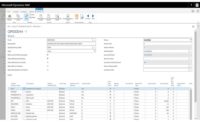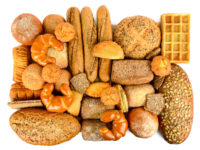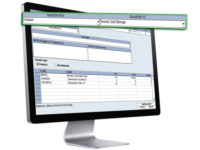Traceability is an important facet of warehouses, especially for snack and bakery companies. In the case of a recall, it is necessary to be able to find out where ingredients came from, and how to best quickly dispose of the affected products.
“Today’s definition of transparency isn’t the same as it was 20 years ago. Consumer demand, recall frequency, and regulatory requirements, including the proposed FSMA 204 enhanced traceability rule, have all contributed to the need for greater visibility and comprehensive supply chain traceability,” says Katy Jones, chief executive officer, FoodLogiQ, Durham, NC.
The U.S. Food and Drug Administration (FDA) defines food traceability as “documenting and linking the production, processing, and distribution chain of food products and ingredients,” she says.
“One of the four pillars of the ‘New Era of Smarter Food Safety’ is tech-enabled traceability. The ultimate goal is to support end-to-end traceability across our food ecosystems. To that end, FDA is exploring ways to encourage the adoption of tracing technologies to support supply chain visibility and interoperability. This will help protect consumers and speed up the identification and removal of products from the marketplace when necessary,” Jones notes.
A robust, whole chain traceability system employs modern technology to provide food companies with visibility into their supply chains, she adds.
“In the event of a food recall or safety incident, it would be easier to pinpoint the source of a product, how far it has traveled, and all the suppliers involved in its journey. This way, you can resolve food safety incidents faster [and] execute more precise food recalls while reducing waste and improving efficiency in the food chain,” Jones comments.
As part of the “New Era of Smarter Food Safety,” in November 2022, the FDA will finalize enhanced traceability requirements in the Food Safety Modernization Act (FSMA) 204 regulation. When the final rule is published in November 2022, it will be imperative for stakeholders to assess how they are preparing and identify areas of opportunity for collaboration and information sharing, she says.
“With FoodLogiQ Connect, companies have a comprehensive platform for monitoring food safety compliance, collecting traceability event data, enabling supply chain visibility, and enhancing recall management,” Jones finishes.
Terri Ghio, president of North American operations, FactoryEve, Irvine, CA, says many modern-day consumers are demanding sustainable, organic, and non-genetically modified foods and traceability can prove to consumers that they are purchasing products that live up to these claims.
“Traceability can help by increasing oversight of the products’ lifecycle, which can reduce contamination, disease, and spoilage, since items are tracked from the beginning. For companies, this can help reduce the chance of product recall while increasing brand protection and consumer confidence,” she notes.
“In the unfortunate event of a recall, traceability allows for all impacted foods to be removed from the shelves to protect consumers, but also allows companies to target only the impacted products instead of having to perform a broader, more expensive recall,” Ghio shares.
She says that smart solutions can greatly help with FDA’s New Era plan since it suggests that more changes are going to be occurring in the food system over the next 10 years than we have seen over the past several decades, thanks to the food system becoming more digitized.
“By digitizing more operations, companies can get ahead of their competitors while increasing company transparency and product traceability. This new approach to food safety will leverage smart technology, like Industry 4.0 solutions, to create safer and more traceable food systems for consumers,” Ghio predicts.
Shaman Ahuja, senior director and head, Axele, a division of Optym, Coppell, TX, says that traceability helps to reduce contamination and spoilage of food products by tracking the food from “farm to table.”
“Traceability identifies certain hazards that might make the food products unsafe for human or animal consumption. For example, in May of this year, J. M. Smucker Company recalled multiple Jif brand peanut butter types because of a Salmonella infection risk. This includes baked goods that use peanut butter as an ingredient,” he says.
“The tainted peanut butter, sold across state lines, has made several people ill after eating the brand and was traced back to a facility in Kentucky. Without the ability to trace food products, more people could have become ill,” Ahuja explains.
The FDA’s New Era Plan requires traceability data in digital form. The Axele TMS collects data from transportation processes and events and can send this data to other systems that would use it, he says.
“As for trucking and transportation processes, there are many types of track-and-trace software/solutions being used to capture data and events. Electronic logging devices (ELDs) and telematics devices deliver GPS-based tracking. There has been an increase in solutions that also rely on location tracking using mobile applications running on the driver’s phone or tablet,” Ahuja notes.
“The best types of solutions are those that factor in both types of technologies and ‘see’ the driver’s schedule, because they factor in loading time, delays, idling times, and more to provide the most accurate ETAs. Just knowing where the truck is does not accurately predict when it will arrive. Making sure trucks arrive on time when delivering food products cuts down on spoilage, damage, and potential foodborne diseases.”
Company: FoodLogiQ
Website: www.foodlogiq.com
Logistics Snapshot: FoodLogiQ Connect enables supplier management, food safety compliance, quality incident management, recall management, and whole chain traceability on a single cloud platform built exclusively for the food industry, says Jones.
“Specifically for traceability, we have the Track + Trace product. Track + Trace is built on a foundation of GS1 Standards, utilizing Key Data Elements (KDEs) and Critical Tracking Events (CTEs) to support traceability across the food system.”
Top features:
- Monitors food safety compliance
- Collects traceability event data
- Enables supply chain visibility
- Enhances recall management
- Info on food origin, safety, journey, and composition
- End-to-end transparency for growers, processors, manufacturers, distribution partners, to the end of the food chain (grocery stores, restaurants)
Company: Axele
Website: https://axele.com/
Logistics Snapshot: The Axele TMS provides visibility as to the location of a truck. The TMS can follow the truck throughout its daily route and capture all events that occur, says Ahuja.
“This way, food producers and distributors will know if something happened along the route, such as the refrigerated truck broke down and the products were spoiled. The TMS can also monitor events related to expiration dates, damaged goods, raw materials, finished goods, etc.”
Axele offers a TMS for carriers that offers track and trace capabilities with the benefits of helping understand where your drivers, assets, and loads are at all times. In addition, it helps carriers see the big picture of what the workload and driver schedule looks like, so they can better understand where opportunities exist to take on new deliveries and reduce out-of-route miles. Extending track and trace visibility to your customer takes it to the next level and reduces the number of “where are you” driver interruption calls and endless calls back and forth between the carrier and customer, he says.
Top features:
- Track and trace capabilities
- Helps understand where drivers, assets, loads are at all times
- Helps carriers see “big picture” of what workload/driver schedule look like
- Receives feeds from third-party ELD and telematics solutions
- Shares information with the customer via live tracking link
- Automates document management, customer invoicing, driver settlement
- Uses hours of service, driver preferences, load profitability to reduce deadheads and fill transport schedules with the most profitable loads
Company: FactoryEye
Website: https://factoryeye.magicsoftware.com/
Logistics Snapshot: FactoryEye, an affordable Industry 4.0 solution for mid-sized manufacturers, can help digitize more operations, says Ghio.
“The FactoryEye solution supports monitoring of the entire process to enable food and beverage manufacturers to achieve objectives like digitization which consistently ensures that quality management systems are flexible enough to comply with ever-changing plans like the FDA’s New Era plan,” she explains.
Top features:
- Increases performance with live, actionable insights and integrated overall equipment effectiveness
- Plug & Play machine connectivity
- Forecasts upcoming events with out-of-the-box machine learning capabilities
- Reduces costs with accurate, live, cost analysis per product job
- Fully integrates IT systems
- Measures production sites with unified KPI system
- Streamlines manufacturing workflow from initial inquiry through final delivery
- Integrates Sales and Operations Processes
- Automatically updates ERP system with accurate, real-time manufacturing data







